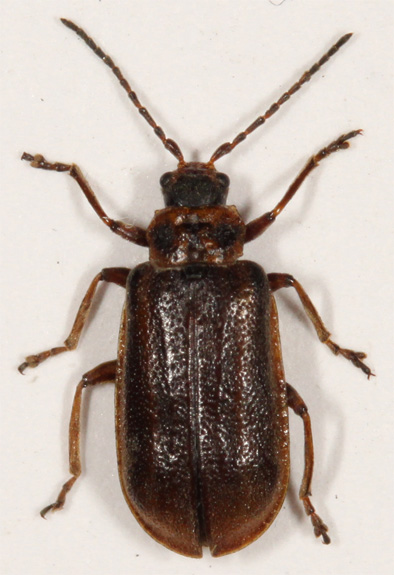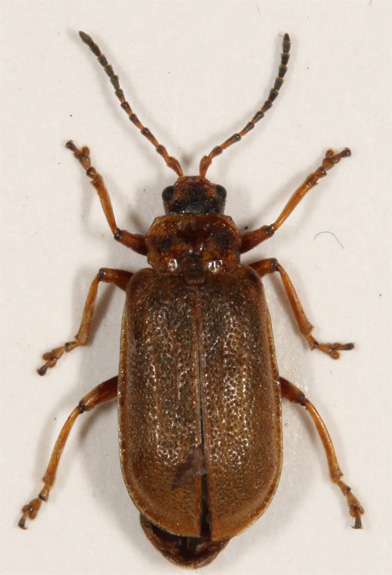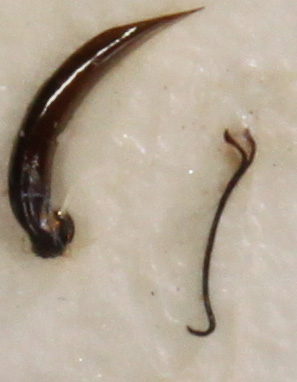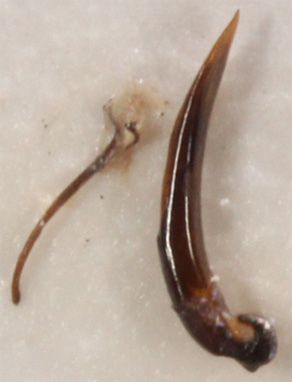G.nymphaeae
G.calmariensis
There have been reservations as to whether these two are separate species; Fowler keys both but states 'I still feel some doubt as to their distinctiveness'. Joy doesn't key sagittariae but instead includes grisescens (Joannis)(sagittariae Brit Cat.) and fergussoni Fowler. In this case grisescens is indeed sagittariae, the true grisescens (Joannis) is no longer included on the British list (Hincks, 1950) and fergussoni is synonomised with sagittariae, possibly a darker aberration, (ibid Hincks). Hincks keys sagitarriae as a variety of nymphaeae. Bienkowski keys both separating on colour and body length and Warchalowski again both on length. Nokkala and Nokkala (1998) confirmed the two as separate species by chromosomal and chorion polypeptide analysis in 1998.
Morphologically these two species are virtually identical and in many keys separation has been achieved using colour and size, with nymphaeae being the larger and darker species. Like many other Galerucella species there is a large amount of intraspecific variation which may lead to a degree of overlap between species so it is best to use a combination of various characters and foodplant to achieve an accurate ID, even then it can sometimes be best guess. The good news is that where found (certainly locally) they are in large numbers especially in the spring. Almost all the specimens examined in preparing this section were from two large breeding colonies; sagittariae from water dock along the bank of the river Gade running through Common moor and nymphaeae from Nymphaeae on an ornamental pond at the nearby Croxley Business Park.
Size
| nymphaeae | sagittariae | |
| Fowler | 6.0-8.0 | 4.0-5.0 |
| Joy | 6.0-8.0 | 4.0-6.0 |
| Hincks | 6.0-8.0 | 4-5.5 |
| Bienkowski | 5.6-6.3 | 4.5-5.1 |
| Warchalowski | 5.4-6.3 | 4.5-5.1 |
As you can see from the above table all previous authors favour sagittariae as the smaller species, however Mike Cox (Pers. Com.) doesn't believe this to be reliable and Hippa and Koponen (1986) show that body length is only reliable across a population mean and not necessarily reliable for individual specimens. Our own experience, certainly locally, agrees with this.
Elytral Colour
Overwintered adults will show the most typical colouration of both species. We feel it is best to record Galerucella in the spring as many species can only be reliably identified from the male and the chances of encountering mating pairs is much higher since the new generation emerging in the late summer is not sexually mature and will not mate until the following spring.

nymphaeae
Dark testaceous to almost black with explanate margins lighter sometimes strikingly so in fresh specimens. Humeri normally darker, almost black sometimes in lighter specimens proceeding in a longitudinal black streak to apex (or almost so).

sagittariae
Light testaceous (although set specimens darken with age). Lighter elytral margins less noticeable. Sometimes with darker humeri but rarely continuing to apex.
The colour of the legs and thorax will normally follow the intensity of the elytral colour ie elytra dark: thorax and legs dark.
Male Genitalia
The aedeagi of both species are basically identical and are not a great deal of use although Warchalowski and Hippa and Koponen (ibid) suggest a difference in the shape of the internal endophallic sclerite, we have not found this particularly useful. There is a more reliable although still variable difference in the apex of the spiculum. In nymphaeae the apex is generally acuminate and when attached to the aedeagus points towards the apex of the aedeagus, in sagittariae the apex of the spiculum is blunter sometimes appearing almost bifid and when attached is more lateral. As with most characters in this species complex there is a great deal of intraspecific variation.
nymphaeae with spiculum attached |
 nymphaeae |
 sagittariae |
Foodplant
There is some salvation in the preferred foodplant of each species; nymphaeae attacks aquatic hosts ie water lilies (Nymphaea alba and Nuphar lutea) whereas sagittariae feeds on semi-aquatic hosts such as water dock (Rumex hydrolapathum) and Rosaciae spp.
This foodplant preference has lead to morpholgical differences in the larvae (Hippa and Koponen); The thorax and abdomen of nymphaeae larvae appear to be dull this is due to small conical papillae whereas the entire dorsal surface of sagittariae larvae is smooth and appears shiny. These papillae in nymphaeae help to retain a film of air when the larvae are submerged, a frequent occurence in water lilies but not so in the large and erect Rumex hydrolapathum.
Conclusion
Getting a 100% reliable ID for specimens of these two species is always going to be difficult and when trying to ID individual specimens (that is single specimens found on their own rather than with others in a colony) will be best guess. They are normally both found in numbers (locally 100 plus) on their respective foodplants and this is the best aid to identification; lighter and on water dock - sagittariae, darker and on water lily - nymphaeae.
References
Bienkowski, 2004. Leaf beetles of the eastern Europe.
Cox, M., 2007. Atlas of the seed and leaf beetles of Britain and Ireland. Pisces.
Fowler, W., 1890. The Coleopter of the British islands. Reeve and Co.
Hincks, W., 1950. The British species of the genera Pyrrhalta and Galerucella. Journal of the society for British entomology 3:150-156
Hippa, H. and Koponen, S., 1986. Morphological, cytological, ecological and ethological evidence of reproductive isolation between Galerucella nymphaeae and G.sagittariae in Fennoscandia. Annales Entomoligici Fennici 52:49-62.
Joy, N., 1932. A practical handbook of British beetles.
Nokkala, C. and Nokkala, S., 1998 Species and habitat races in the chrysomelid Galerucella nymphaeae species complex in northern Europe. Entomologica Experimentalis et Applicata 89: 1-13.
Warchalowski, A., 2003. Chrysomelidae, the leaf beetles of Europe and the Mediterranean area. Natura optima dux Foundation.